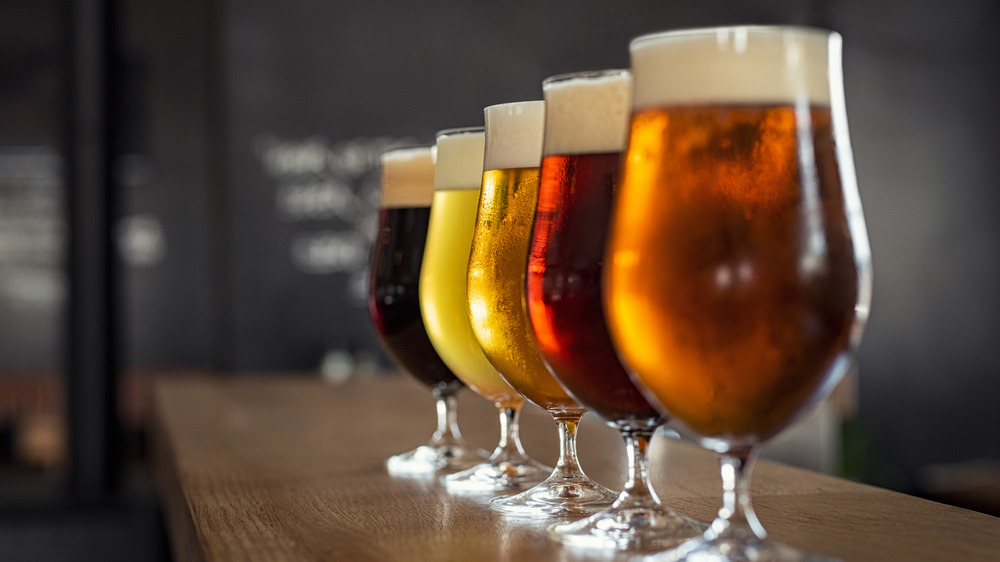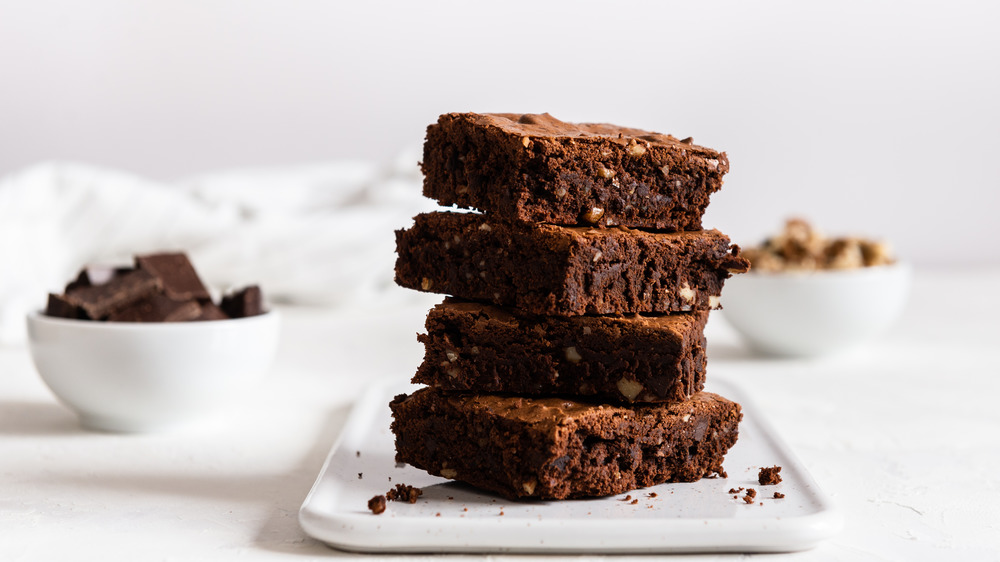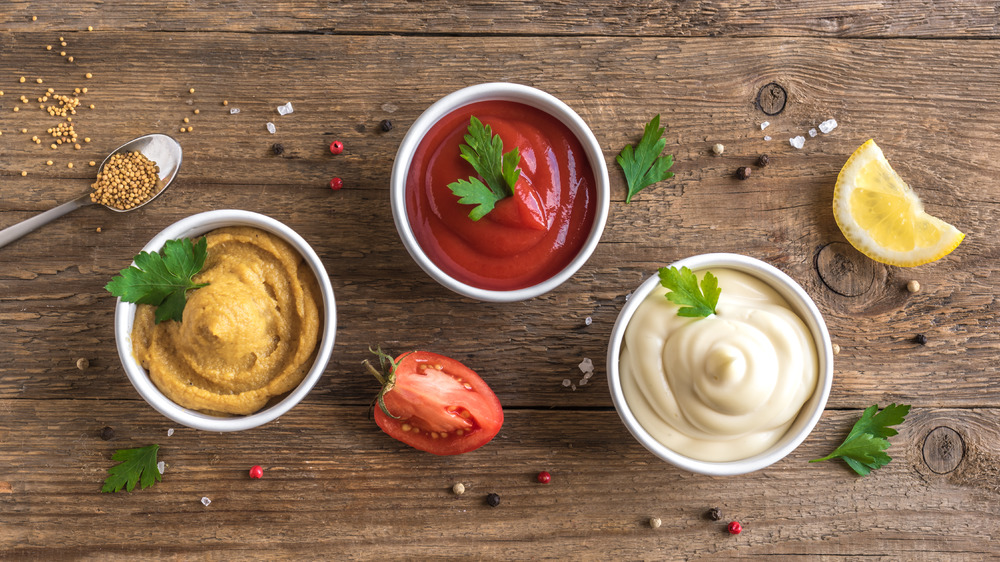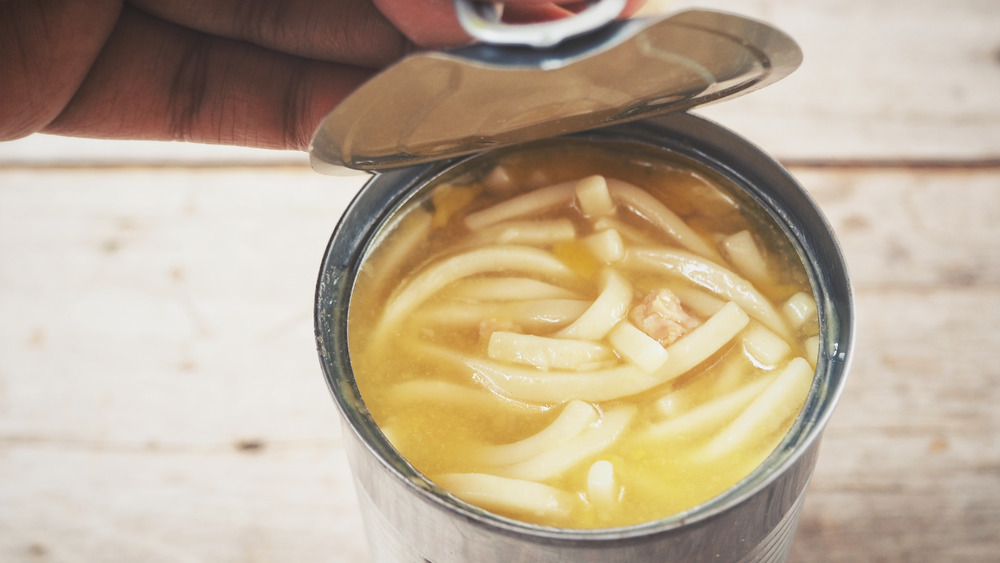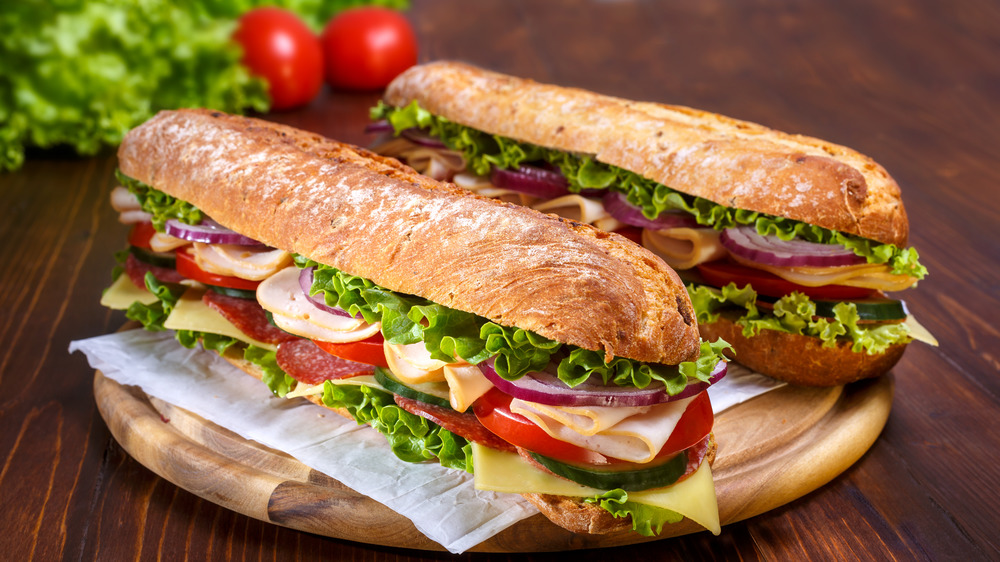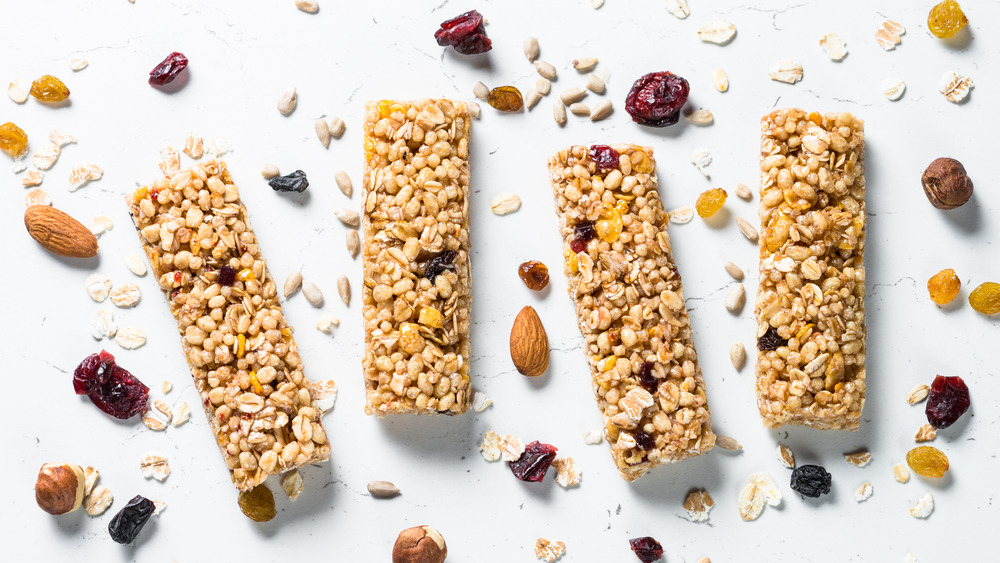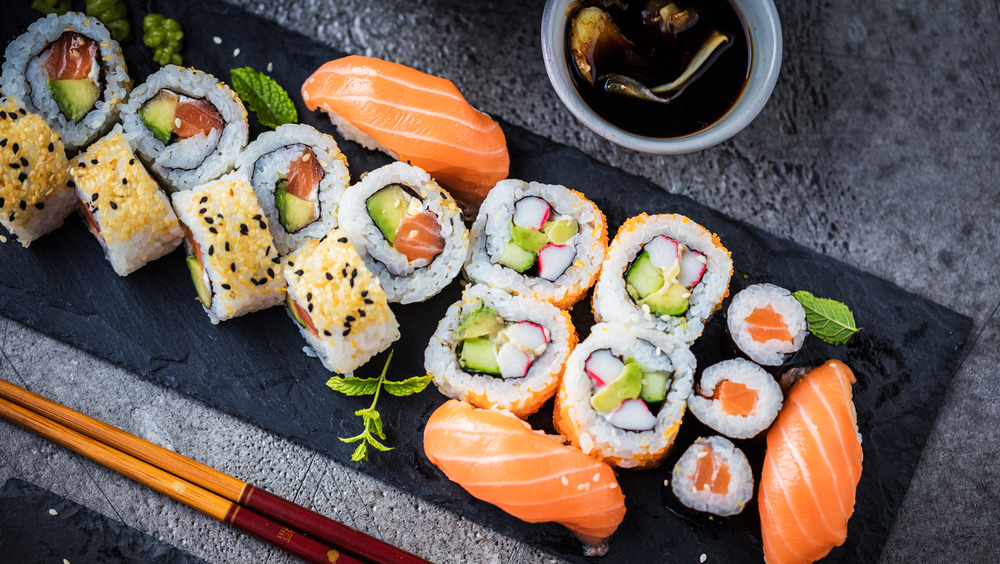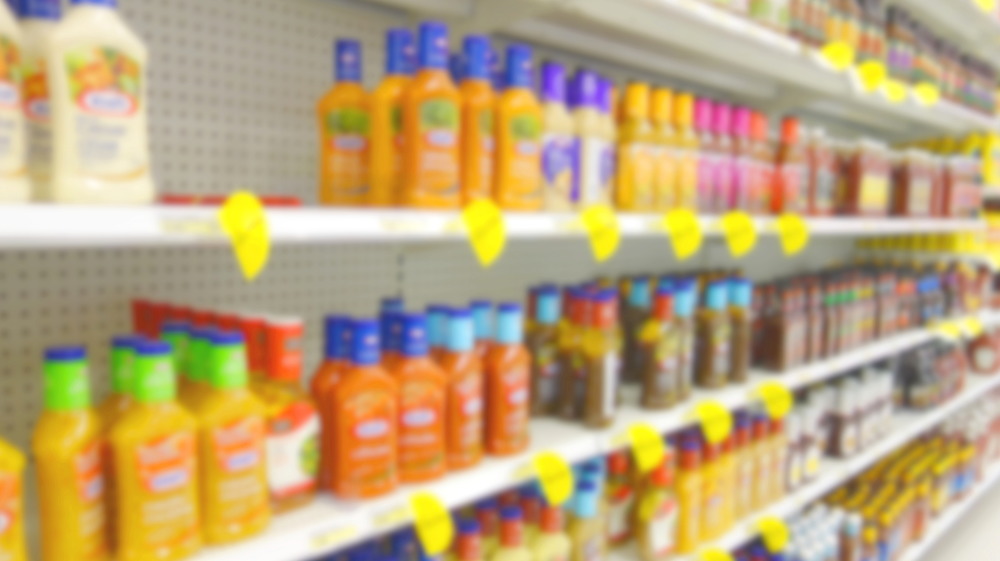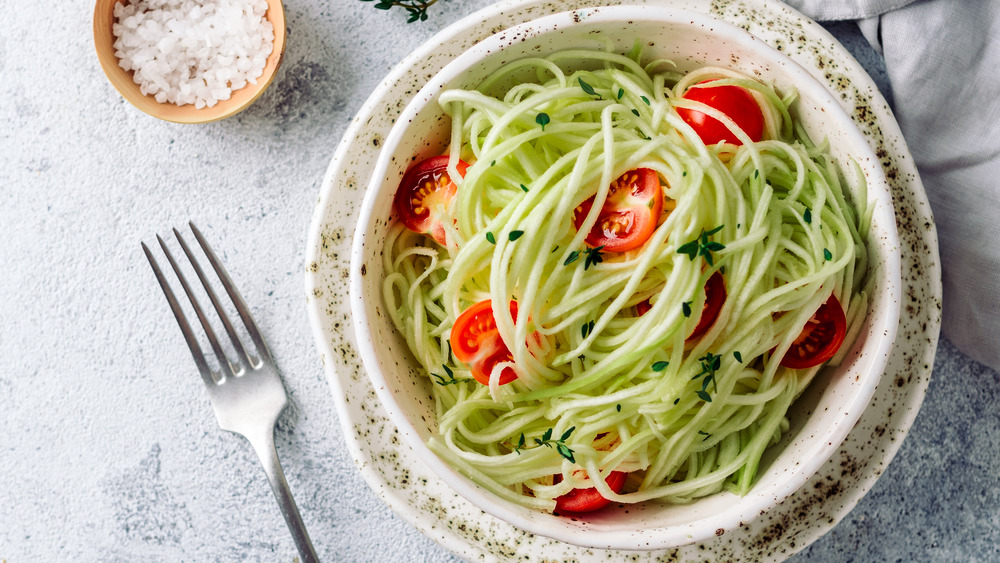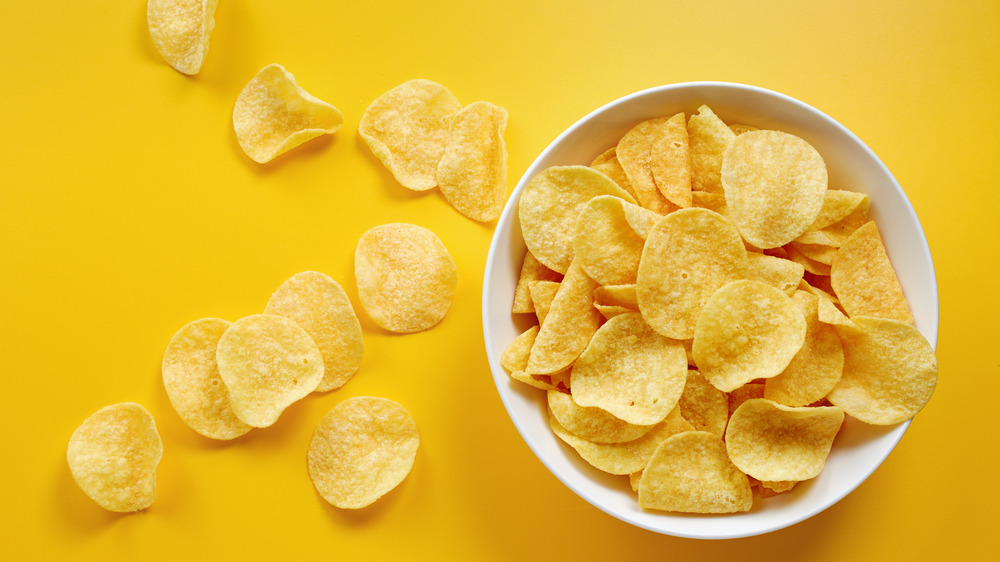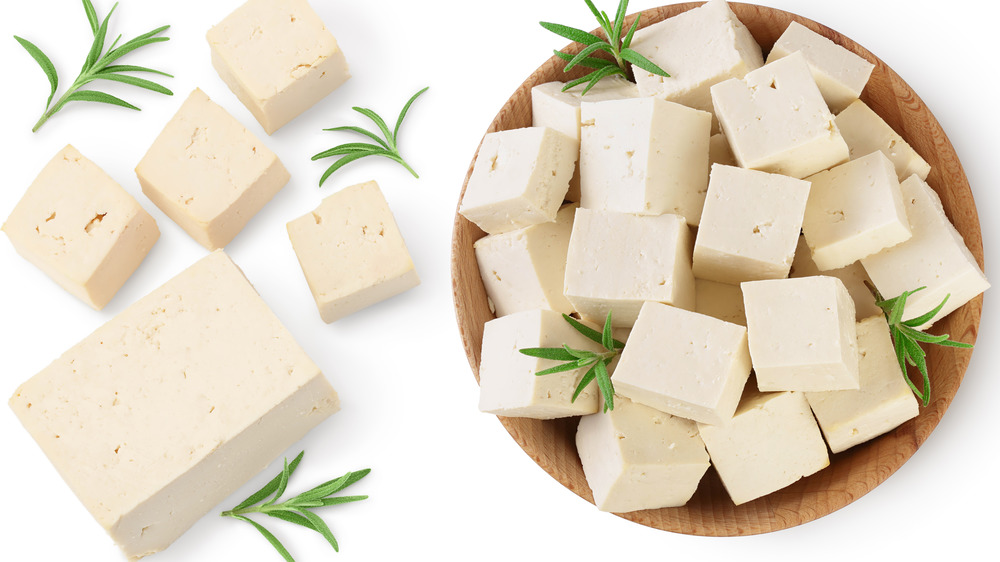Foods You Probably Didn't Realize Weren't Gluten Free
Gluten is a protein naturally found many types of grains, including wheat, rye, barley, farina, and wheat berries (via Mayo Clinic). It is often added as a binder to hold foods together and give them a stretchy quality. As gluten is a component of many grains, its also often found in grain-containing foods like breads, pastas, and cereal. However, it is not exactly necessary to consume. According to Harvard Medical School, gluten provides no essential nutrients.
Of all the gluten-containing grains, wheat is the most common (via Harvard's The Nutrition Source). Although you've likely heard of gluten, you may not know about the two main proteins within gluten: glutenin and gliadin. According to a 2017 report in the Journal of Gastroenterology and Hepatology, gliadin is responsible for most of the adverse health effects associated with gluten, including gastrointestinal symptoms and life‐threatening anaphylaxis (a severe allergic reaction).
Most people can tolerate gluten and will not have adverse effects to gluten. However, gluten can cause serious problems for people with celiac disease, gluten sensitivity, and wheat allergies (via Harvard School of Public Health). While such people will want to limit if not avoid gluten, it can be hard to know which foods have the wheat protein just by looking at them. Here are some foods you probably didn't realize weren't gluten free.
Even if the label on your coffee says gluten free, it might not be
Plain coffee is generally gluten free, but it is possible for coffee to be cross-contaminated, especially if it has been processed at a facility that handles other gluten-containing products. And when you add creamer and sweeteners, the odds for gluten go up.
As explained by U.S. News & World Report, once you introduce flavorings to coffee like syrups and powder mixes, and other mix-ins, the more likely it is for a person with celiac disease to have a reaction. Furthermore, you should never assume that seasonal coffees, flavored coffees, or other mixed coffee drinks are gluten free unless you have verified the ingredients.
You may also want to avoid instant coffee. A study published in 2013 in the journal Food and Nutrition Sciences found that instant coffee could cause a negative response in people who are gluten-sensitive because it was cross-contaminated with traces of gluten. The study's authors concluded that pure coffee was probably the safest choice for people with gluten sensitivity or celiac disease.
Beer generally isn't gluten free
Beer is typically made using water, hops (from the humulus lupulus plant), yeast, and grains like barley, wheat, and rye (via Tapville). The majority of these ingredients contain gluten. A brewery may also add other grains, sugars, flavors, and additives to give beer its distinct color, taste, and/or smell, and some of those ingredients might also contain gluten (via ABC News).
However, several alcoholic beverage companies make gluten-free beer. According to Healthline, gluten-free beer is brewed with gluten-free grains like rice, buckwheat, corn, or millet. Another option is gluten-removed beer, which is made with gluten-containing grains but processed with enzymes that digest gluten particles to the point where they pose little risk. Of course, that does mean gluten-removed beer may still contain tiny amounts of gluten.
As part of a 2017 study published in the Journal of AOAC International, blood samples were taken from celiac disease patients to be tested on barley, regular beer, and gluten-free beer. Researchers found that out of 31 patients, 11 experienced reactions to the barley, four experienced reactions to regular beer, and two experienced reactions to the gluten-free beer (via celiac.com).
Your favorite chocolate might not be gluten free
Pure chocolate generally does not contain gluten (via Healthline). However, many types of chocolate candy bars and chocolate desserts are mixed with gluten. And even with chocolate that is considered gluten free, it is important to be aware of cross-contamination.
Chocolate can become contaminated with wheat, barley, or other sources of gluten during the creation process. According to a 2017 report in Nutrients, this occurs because particles of gluten are transferred from one product to another, increasing the risk for gluten exposure to people unable to tolerate gluten.
To avoid gluten exposure, opt for products that are certified gluten free (via the Gluten-Free Certification Organization). Only products that have met certain manufacturing requirements are able to receive a gluten-free certification. This certification ensures the products are safe for people who have celiac disease or gluten sensitivity. The amount of certified gluten-free foods is ever-expanding, so if you are unsure if your favorite chocolate bar or dessert is gluten free, look for an approved seal on the package. You should also take the time to read product labels and other important information on the packaging.
Sauces, condiments, and gravies might not be gluten free
Condiments like ketchup and mustard can make your favorite foods more enjoyable. But they may just contain unexpected amounts of gluten. This is because gluten works well as a binder and thickener in certain sauces (via Mayo Clinic). Gluten can also keep dry products like spices from clumping to together.
According to the Healthline, some condiments that contain gluten include ketchup, barbecue sauces, soy sauce, and gravy mixes. And as the Celiac Disease Foundation explained, even condiments that don't typically contain gluten, like mayonnaise, may pose a risk because they can "become contaminated when utensils used on gluten-containing food are double-dipped."
One way to avoid the side effects of gluten from condiments is to make your own gluten-free condiments, per Healthline. Another option is to purchase condiments that are certified gluten free. More and more companies are making gluten-free condiments and it is likely that your local grocery store has what you need.
Not all canned soup is gluten free
Canned soup is a convenient option for a quick lunch or dinner. All you have to do is open a can, pour, maybe add water, heat, and enjoy. There is no chopping up meat or vegetables or waiting for hours to enjoy a simmering soup. Unfortunately, most types of canned soup are not gluten free. This is because companies often use wheat to thicken soup and give it a creamy texture, according to the Celiac Disease Foundation. In fact, the foundation said soups are "one of the biggest sources of hidden gluten." They suggest reading nutrition labels before buying canned soup — especially those that contain cream.
Thankfully, some soup manufacturers, like Progresso and have begun producing soup flavors that don't contain wheat, barley, rye, or other gluten-containing ingredients. Keep in mind, though that many of these products are certified gluten free because there is a low enough level of gluten to qualify (via Food and Drug Administration). They may still contain trace amounts of gluten, which might affect people who are extremely sensitive to gluten. A better and safer option is to make your own gluten-free soup at home. Make it in bulk so you can freeze some to enjoy later.
Deli meat isn't necessarily gluten free
There might be trace amounts of gluten in your favorite deli meats, so it is always a good idea to read ingredient labels carefully. You should look out for derivatives of gluten, including wheat, rye, and barley.
The Cleveland Clinic suggests checking for hydrolyzed wheat proteins in poultry, meat, and fish products. The clinic continued, noting that "processed lunch meats and deli meats like cold cuts, hot dogs, salami and sausage may contain gluten." Fortunately, there are many gluten-free deli meat options at your favorite grocery store. Make sure you look for deli meat brands that are certified gluten free, suggested the San Francisco Chronicle. These products will have a gluten-free statement or logo on their packaging.
If you prefer to have meat sliced at the deli counter, you will want to avoid cross-contamination. Ask deli staff to change gloves and clean their work surface and meat slicer before handling your order. If you give the deli some notice, the deli can make sure those precautions are in place in advance (via San Francisco Chronicle).
Granola bars can be sneaky sources of gluten
Many store-bought granola bars are made with oats. And while oats are generally gluten free, they can be easily cross-contaminated with grains containing gluten during harvest, storage, and processing (via Celiac Disease Foundation). Even granola bars that use other grains might contain wheat flour and wheat germ. They might also contain malt extract or malt syrup. And according to Beyond Celiac, malt extract and malt syrup are not gluten free. "The word malt' on a food label usually indicates that there is gluten in the product," the site explained.
You don't have to give up granola bars to avoid gluten, however. There are plenty of gluten-free granola bar options you can safely enjoy. Some are even manufactured at gluten-free facilities to avoid cross-contamination (via Spokin). Of course, the safest and healthiest option would be to make your own granola bars at home. By using all gluten-free ingredients, including certified gluten-free oats, you can avoid a reaction. And you can add other gluten-free options to your granola bars, including dry and fresh fruit, nuts and seeds, and your favorite gluten-free candies.
Not all candies are gluten free
Some candies are gluten free while others are not. Some that are not considered gluten free may not contain any gluten ingredients, but still might not be safe due to their manufacturing processes. You should read labels each and every time you want to enjoy your favorite candy because product ingredients and manufacturing facilities can change. And if you are not sure, get in touch with the manufacturer directly.
"Additionally, the candies that are gluten-free in the United States may not be gluten-free in other parts of the world," per Healthline. According to the site, candies that contain wheat, rye, malt vinegar, spelt, barley, kamut, farina, triticale, or vital gluten semolina are not gluten free.
Thankfully, some of the major candy companies, like Hershey, keep updated lists of their gluten-free candies on their websites. An expansive list of gluten-free candies is also available at the Celiac Disease Foundation's website. And of course, always read the labels carefully and talk to your doctor about any specific questions you might have.
Some kinds of sushi are gluten free, while others are not
On the surface, sushi would seem like a gluten-free meal, but any sushi that contains imitation crab meat (aka surimi) or tempura may contain gluten. Soy sauce and other marinades might not be safe for people with celiac disease or gluten allergies and sensitivities, according to Beyond Celiac, and sushi rice might also contain wasabi and vinegars containing gluten.
Cross-contamination is also a concern with sushi rice. Sushi chefs often prepare each order using the same preparation surface and the same utensils. Registered dietitian Rachel Begun shared with Beyond Celiac that even if "sushi rice is made with distilled white vinegar or rice vinegar and doesn't contain other gluten-containing ingredients, you can still come into contact with gluten if the sushi preparer isn't careful about preventing cross-contamination with sushi pieces that utilize soy sauce and/or other ingredients containing gluten." When ordering sushi, inform your server of your allergy and see if your sushi can be prepared without cross-contamination.
Read the labels on your favorite salad dressings to check for gluten
Many salad dressings contain gluten-containing additives (via Gluten-Free Living). While in the grocery store, check the label on the salad dressing bottle to see if it contains wheat. If it does, well, it is certainly not gluten free. Wheat isn't the only ingredient to search for, though. Scan the label for other sources of gluten, including rye, barley, dextrin, malt vinegar, food starch, flour, or soy sauce.
Instead of scouring through all the dressings at your local grocery store, you may find it much easier to stick with certified gluten-free salad dressings. This is also safer because products that are not labeled certified gluten free have not been tested for gluten levels. The Celiac Disease Foundation recommends Hidden Valley salad dressings, which are labeled gluten free and do not feature gluten-containing ingredients. A second safe option is to make your own gluten-free salad dressing at home.
Read ingredient labels carefully when buying noodles and pasta
Most pastas and noodles are loaded with gluten. If you are eating gluten free, you're going to want to steer clear of dumplings, raviolis, gnocchi, chow mein, ramen, and egg noodles (via Celiac Disease Foundation). The best pasta and noodle options for gluten-free eating are those that specifically state "gluten free" or "certified gluten free" on the packaging. These products are made with ingredients like brown rice, corn, and quinoa in the place of wheat.
According to Healthline, some gluten-free pasta and noodle options are made from brown rice, chickpeas, buckwheat, or quinoa. Others are made using a blend of different grains, including corn and millet. Veggies can also replace pastas and noodles and are naturally gluten free (think: zoodles). You can use any type of hard or firm-vegetable to make gluten-free vegetable noodles, including zucchini, squash, and carrots. Add your favorite gluten-free sauce and you'll have a yummy dish.
Potatoes may be gluten free, but potato chips are often not
Potatoes, on their own, are a gluten-free food. But when they are processed into potato chips or french fries, they are often no longer considered gluten free due to added ingredients, like malt vinegar and wheat starch. Cross-contamination can also be an issue when a gluten-free potato dish is prepared in the same areas as foods containing gluten (via Healthline).
Some potato chips are gluten free, but it is important to read the labels on these products and be wary of cross-contamination. Better yet, Healthline suggested skipping the store-bought chips and making your own.
As for french fries, some fast food restaurants do use separate gluten-free fryers, but it is a good idea to ask before ordering (via Verywell Fit). Of course, your safest bet is to make your own French fries at home. The Celiac Disease Foundation's website boasts a tasty and easy recipe for baked fries.
Not all tofu is gluten free
Tofu is often eaten as a plant-based alternative to meat. Its basic ingredients are soybeans, water, and an agent used to curdle soy milk, all of which do not contain gluten. In fact, most plain, unflavored tofu is gluten free (via Healthline). However, some tofu brands might contain gluten, so it is a good idea to read the ingredient labels.
You should pay special attention to tofu that is flavored. Popular flavors include teriyaki and sesame, which may contain soy sauce. And soy sauce is a problem for people with celiac disease or those who have gluten allergies and sensitivities, per Healthline. Fortunately, some flavored tofu varieties contain tamari instead.
Cross-contamination can also be an issue — and long before the tofu even makes it to your plate. Cross-contamination can occur when soybeans are harvested, during processing and manufacturing, at even during your food preparation (via Healthline). Your safest bet is to prepare gluten-free tofu meals at home using tofu brands that are certified gluten free.
Be wary of gluten-free meals at restaurants
There is a good possibility that the gluten-free dish you order at a restaurant will actually contain gluten. According to a 2020 analysis published in the American Journal of Gastroenterology, 32 percent of gluten-free restaurant dishes analyzed contained gluten. In this study, restaurant-goers were given portable gluten detection devices, which they used to check restaurant meals that were advertised as gluten free. Researchers found gluten-free pizza and pasta contained the most gluten. Breakfast foods were also found to be high in gluten.
This is disconcerting, but the Celiac Disease Foundation has provided recommendations for dining out safely. One of their first recommendations is to know which grains to avoid, hidden sources of gluten, and how to avoid cross-contamination. The foundation further recommended choosing restaurants with multiple options for gluten-free eating. You might want to check a restaurant's menus online or call ahead to discuss gluten-free offerings.
Once you are at the restaurant, tell your server about your allergy. "If they don't [understand], tell them that you cannot eat anything that has flour, bread crumbs or soy sauce or you will become very ill," advised the foundation. "If your server does not understand, ask to speak to the restaurant manager or the chef."



